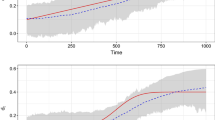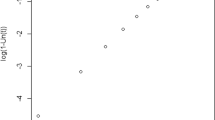Abstract
In this paper, we study, by a Monte Carlo simulation, the effect of the order p of “Zhurbenko-Kolmogorov” taper on the asymptotic properties of semiparametric estimators. We show that p = [d + 1/2] + 1 gives the smallest variances and mean squared errors. These properties depend also on the truncation parameter m. Moreover, we study the impact of the short-memory components on the bias and variances of these estimators. We finally carry out an empirical application by using four monthly seasonally adjusted logarithm Consumer Price Index series.
Similar content being viewed by others
References
Abadir A, Distaso W, Giraitis L (2005) Two estimators of the long-run variance. Discussion paper series 05/09, The University of York
Agiakloglou C, Newbold P, Wohar M (1993) Bias in an estimator of the fractional difference parameter. J Time Series Anal 14:235–246
Alekseev VG (1996) Jackson and Jackson-Vallée Poussin-type kernels and their probability applications. Theory Probab Appl 41:137–143
Beran J (1994) Statistics For long-memory processes. Chapman & Hall, London
Boutahar M, Marimoutou V, Nouira L (2007) Estimation methods of the long memory parameter: Monte Carlo analysis and application. J Appl Stat 34:261–301
Brillinger DR (1975) Time series, data analysis and theory. Holden-Day, San Francisco
Cheung YW, Lai KS (1993) A fractional cointegration analysis of purchaising power parity. J Bus Econ Stat 11:103–112
Cooley JW, Tukey JW (1965) An algorithm for the machine calculation of complex Fourier series. Math Comput 19:297–301
Cooley JW, Lewis PAW, Welch PD (1967) Historical notes on the fast Fourier transform. IEEE Trans Audio Electroacoust 15:76–79
Crato N, De Lima PJF (1994) Long-range dependence in the conditional variance of stocks returns. Econ Lett 45:281–285
Dickey D, Fuller W (1979) Distribution of the estimators for autoregressive time series with a unit root. J Am Stat Assoc 74:427–431
Geweke J, Porter-Hudak S (1983) The estimation and application of long-memory time series models. J Time Series Anal 4:221–238
Giraitis L, Robinson PM (2003) Edgeworth expansions for semiparametric whittle estimation of long memory. Ann Statist 31:221–238
Granger CWJ, Joyeux R (1980) An introduction to long-memory time series models and fractional differencing. J Time Series Anal 1:1325–1375
Hassler U, Wolters J (1995) Long memory in inflation rates: International evidence. J Bus Econ Stat 13: 37–45
Hauser MA (1997) Semiparametric and nonparametric testing for long memory: a Monte Carlo study. Empir Econ 22:247–271
Hosking JRM (1981) Fractional differencing. Biometrika 68:165–176
Hurvich CM, Ray B (1995) Estimation of the memory parameter for nonstationary or noninvertable fractionally integrated processes. J Time Series Anal 16:17–42
Hurvich CM, Deo RS, Brodsky J (1998) The mean squared error of Geweke and Porter-Hudak’s estimator of the memory parameter of a long-memory time series. J Time Series Anal 1:19–46
Hurvich CM, Chen WW (2000) An efficient Taper for potentially over differenced Long-Memory Time Series. J Time Series Anal 21:155–180
Jones RH (1971) Spectrum estimation with missing observations. Ann Inst Statist Math 23:387–398
Kwiatkowski D, Phillips PCB, Schmidt P, Shin Y (1992) Testing the hypothesis of stationarity against the alternative of a unit root: how sure are we that economic time series have a unit root?. J Econom 54:159–178
Kim CS, Phillips PCB (1999) Log periodogram regression: the nonstationary case. Mimeographed, Cowles Foundation, Yale University
Lobato I, Robinson PM (1996) Averaged periodogram estimation of long memory. J Econom 73:303–324
Ljung GM, Box GEP (1978) On a measure of lack of fit in time series models. Biometrika 65:553–564
Maynard A, Phillips PCB (2001) Rethinking an old empirical puzzle: econometric evidence on the forward discount anomaly. J Appl Econom 16:671–708
Olhede SC, Mccoy EJ, Stephens DA (2004) Large-sample properties of the periodogram estimator of seasonally persistent processes. Biometrika 91:613–628
Phillips PCB, Perron P (1988) Testing for a unit root in time series regression. Biometrika 75:335–346
Phillips PCB (2005) Econometric analysis of Fisher’s equation. Am J Econ Sociol 64:125–168
Porter-Hudak S (1990) An application of the seasonal fractionally differenced model to the monetary aggregates. J Am Stat Assoc 85:338–344
Reisen VA (1994) Estimation of the fractional difference parameter in the ARIMA (p,d,q) model using the smoothed periodogram. J Time Series Anal 15:335–350
Robinson PM (1994) Semiparametric analysis of long-memory time series. Ann Stat 22:515–539
Robinson PM (1995a) Log-periodogram regression of time series with long range dependence. Ann Stat 23:1048–1072
Robinson PM (1995b) Gaussian semiparametric estimation of long range dependence. Ann Stat 23:1630–1661
Shapiro SS, Wilk MB (1965) An analysis of variance test for normality. Biometrika 52:591–611
Shimotsu K, Phillips PCB (2004) Exact local whittle estimation of fractional integration. Ann Stat 32:656–692
Sibbertsen P (2004) Long-memory in volatilities of German stock returns. Empir Econ 29:477–488
Taqqu MS, Teverovsky V (1996) Semiparametric graphical estimation techniques for long memory data. Lect Notes Stat 115:420–432
Velasco C (1999a) Non-stationary log-periodogram regression. J Econom 91:325–371
Velasco C (1999b) Gaussian semiparametric estimation of non-stationary time series. J Time Series Anal 20:87–127
Zhurbenko IG (1979) On the efficiency of estimates of a spectral density. Scand J Stat 6:49–56
Author information
Authors and Affiliations
Corresponding author
Rights and permissions
About this article
Cite this article
Nouira, L., Boutahar, M. & Marimoutou, V. The effect of tapering on the semiparametric estimators for nonstationary long memory processes. Stat Papers 50, 225–248 (2009). https://doi.org/10.1007/s00362-007-0071-6
Received:
Revised:
Published:
Issue Date:
DOI: https://doi.org/10.1007/s00362-007-0071-6




